


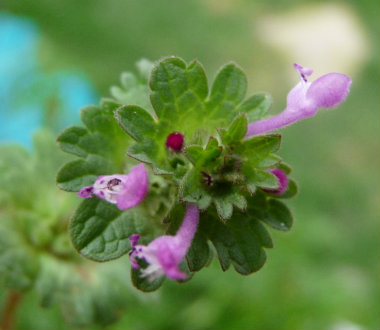
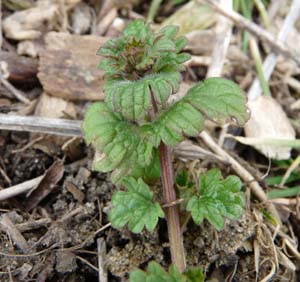
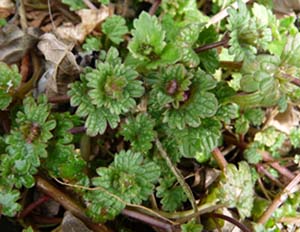
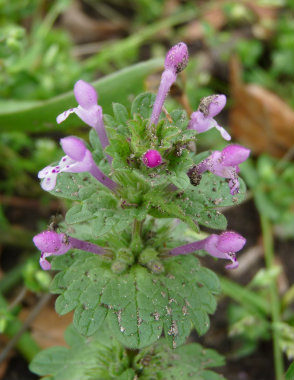
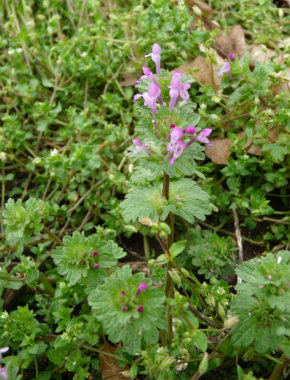
To support our efforts please browse our store (books with health benefits, etc.).
The common name, Henbit, comes from the observation that chickens like it. Humming birds also enjoy this wild edible for the nectar. Henbit provides valuable erosion control in many cropland fields in the southern U.S. Unlike many of its relatives in the mint family, it does not have a strong or distinctive mint scent. It is also easily confused with Purple Deadnettle (L. purpureum), which has petioled leaves all the way to the top leaves. The middle and upper leaves of L. amplexicaule (henbit) do not have petioles, and the leaves are typically smaller than those of Purple Deadnettle. This edible plant is also an important early season source of nectar and pollen for honeybees.
Distinguishing Features
Henbit is a winter annual that grows between 10 and 30 centimetres tall. This edible plant is sparsely covered with fine hairs that point downward, and it grows from a shallow taproot that becomes finely branched. The low growing, upright to sprawling plants have a number of weak stems arising from the base that may be erect or almost lay on the ground. The stems are square and green but often become purple with age and may root at the lower nodes. This edible weed reproduces solely by seed, and each henbit plant can produce 2,000 or more seeds. It also spreads by producing roots on lower stems that touch the ground.
Flowers
Tiny, dark pink flowers occur in rings in the upper leaf axils. Open flowers are somewhat orchid-like, with a white face and dark red spots. Each flower produces a four-seeded fruit.
 Fields
of Nutrition has medicinal benefits and vitamin/mineral content of Henbit.
Fields
of Nutrition has medicinal benefits and vitamin/mineral content of Henbit.
Leaves
Leaves are arranged in opposite pairs. The lower leaf pairs are farther apart from each other than the upper leaf pairs. Leaves are round or heart-shaped, are .95 - 1.9 centimetres long, and leaf margins have rounded teeth. Veins of the upper leaf surface are recessed, giving it a somewhat wrinkled look. Lower leaves grow on short stalks, and upper leaves clasp the stem.
Height
This wild edible can grow anywhere between 10 and 30 centimetres high.
Habitat
Henbit grows by roadsides, in cropland, pastures, in waste areas, in gardens, and on lawns. It prefers light, dry soil and cultivated soil, and it originated in Eurasia and Northern Africa. It also grows in Australia, South America, western Asia, Greenland, and throughout Canada and the United States.
Edible Parts
Henbit can be consumed fresh or cooked as an edible herb, and it can be used in teas. The stem, flowers, and leaves are edible, and although this is in the mint family, many people say it tastes slightly like raw kale, not like mint. It is very nutritious, high in iron, vitamins and fibre. You can add it raw to salads, soups, wraps, or green smoothies. According to Natural Medicinal Herbs this edible plant is anti-rheumatic, diaphoretic, an excitant, febrifuge, a laxative and a stimulant.
Similar Plants
Winter Survival Food Handbook

PDF Plant Magazines
Types of Wild Food
Geographic Zones Seasons
Disclaimer
EdibleWildFood.com is informational in nature. While we strive to be 100% accurate, it is solely up to the reader to ensure proper plant identification. Some wild plants are poisonous or can have serious adverse health effects.
We are not health professionals, medical doctors, nor are we nutritionists. It is up to the reader to verify nutritional information and health benefits with qualified professionals for all edible plants listed in this web site. Please click here for more information.
Why Edible Wild Food?
- Food costs are rising
- Free, wild food is readily abundant
- Wild food adds nutrition to your diet
- Wild food can help treat various medical conditions







